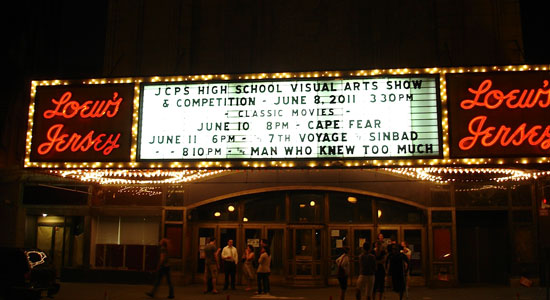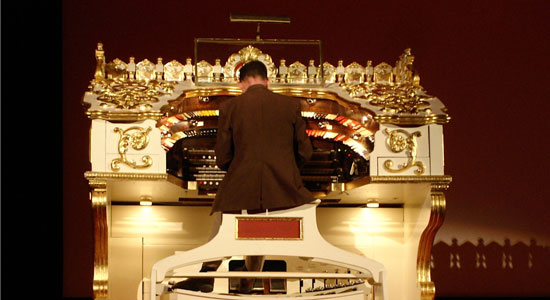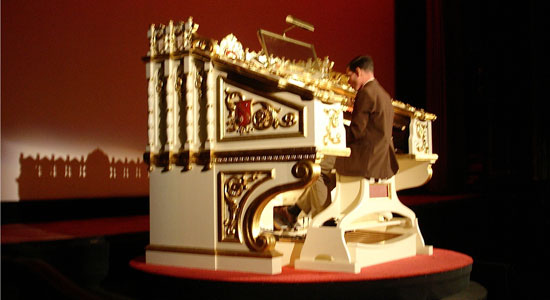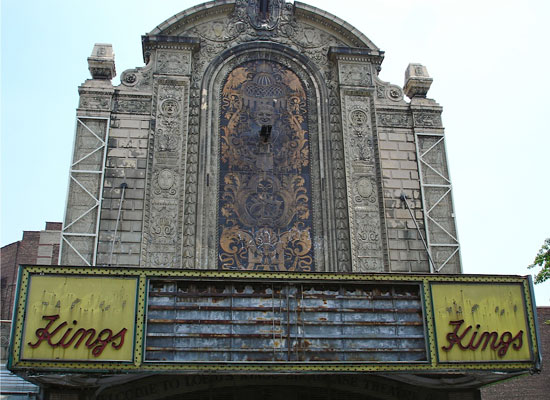 The Ladybug Transistor formed in Brooklyn in 1995, and frontman Gary Olson has been the band’s sole constant member. Clutching Stems (Merge) is the group’s seventh album and the first to be made following the 2007 asthma-related death of drummer San Fadyl. Since, the band’s lineup has solidified behind Olson, featuring Kyle Forester, Julia Rydholm, Mark Dzula, Eric Farber and Michael O’Neill. The Ladybug Transistor will be guest editing magnetmagazine.com all week. Read our brand new Q&A with Olson.
The Ladybug Transistor formed in Brooklyn in 1995, and frontman Gary Olson has been the band’s sole constant member. Clutching Stems (Merge) is the group’s seventh album and the first to be made following the 2007 asthma-related death of drummer San Fadyl. Since, the band’s lineup has solidified behind Olson, featuring Kyle Forester, Julia Rydholm, Mark Dzula, Eric Farber and Michael O’Neill. The Ladybug Transistor will be guest editing magnetmagazine.com all week. Read our brand new Q&A with Olson.

Gary Olson speaks with Garden State Theatre Organ Society president Michael Cipolletti
Growing up the son of a minister, I have certainly clocked up a lot of hours in church. My father’s church in Flatbush, Brooklyn, had a pipe organ so large that you could walk inside it. I remember being taken by its variety of tone. The dynamic leap of its bench-shaking bass to the delicate high of chiming bells. This fascinating instrument certainly made an impression on a very young me. Over the past year or so I have gone to see several films at the Loew’s Jersey Theatre: a beautiful 1930s-era movie palace that is undergoing renovation. Before most showings, the audience is treated to the sounds of its mighty Robert Morton Theater Organ. They often feature a silent movie in the monthly program with full organ accompaniment. The Loew’s organ restoration and installation was completed in 2007 by the Garden State Theatre Organ Society. Very special thanks to GSTOS president Michael Cipolletti, who was kind of enough to answer a few questions about their mission. Please visit the Loew’s Jersey Theatre to hear and see the finest example or their work.
Olson: First, can you tell me a bit about the Garden State Theatre Organ Society?
Cipolletti: First, I presume you have visited the GSTOS website. It gives you a good picture of what we do, but here is a synopsis. GSTOS was founded in 1973 because we were watching the last remaining movie palaces and their pipe organs become warehouses or become demolished and lost to history. You will note that cities like Jersey City began to realize they were losing their centers of entertainment, and some movements grew to save the last of these theatres. At one time, there were three significant (3,000-4,000 seat) theatres at Journal Square. Today, only Loew’s remains. The Stanley Theatre is nearby, but it has become a house of worship.
New York City was one of the worst cities for demolition. As you know, NYC is very progressive and is quick to demolish and build new things. Even Radio City Music Hall was but days from closing and being turned into something dreadful. Some of the organs were salvaged and were moved to the Midwest and the West Coast, where they were utilized in cultural centers. At least a few are still in existence, but New York has suffered great loss. There are probably only four left in NYC, and only Radio City’s organ is even playable.
So, GSTOS managed to hang onto a few of these instruments. We still lost some because corporate owners didn’t want to be bothered by some preservationists. We’re lucky to have four instruments that we own and maintain. We maintain several others in cooperation with their owners. For example, we maintain the Moller pipe organ in the Patriots Theatrer in the War Memorial in Trenton. It’s a state owned building, and we have a cooperative contract to maintain the instrument. In exchange, we have use privileges.
GSTOS is not-for-profit, a 501.c.3 charitable corporation. None of us receives a salary. We volunteer our time, our expertise, our gasoline to get to and from the locations. Our fund raising is mostly from people who are generous, as ticket sales do not cover the cost of productions or concerts. We are fortunate in that New Jersey has Stevens Institute and other technical colleges. We also have Bell (ATT Labs), and as a result, we have numerous engineers living in this state. These people have taken the 85-year-old pipe organs and refitted them with solid-state relays and computer controls. The pipe work is still played exactly the same from the exact same consoles, but the brains have been upgraded to reliable and compact up-to-date electronics.
In addition to preserving and presenting pipe organs, we have become a social organization whose members partake cultural and recreational activities together. It has truly become a family network.
An interesting note is that, once upon a time in 1932, there was a Wurlitzer in the Rainbow Room at 30 Rockefeller Plaza. Yes, 65 stories above the ground. It was used to play between orchestra sets and to entertain people when they were in the lounge. With the advent of high-fidelity sound, the organ was no longer needed and was sold off and made a few stops before we aquired it and have it nearly completed in a reinstallation in Rahway, N.J.
Tell me a bit about the restoration of the Robert Morton organ at Loew’s Jersey Theatre. It sounds magnificent. It must be a thrill to play one of these in a space truly designed for it.
The organ was purchased in a warehouse. It had been dismantled and stored for years in anticipation of installing it in the Chicago area. When we transported it back to New Jersey, it had no blueprint or directions. In addition to rebuilding it, the parts had to be distinguished and puzzled together before beginning the reinstallation process. The electronics control little magnets at the bottom of each pipe. The magnet opens a valve that looks like a miniature fireplace bellow. That opens another valve that allows the air to blow into the pipe. Every one of these had to be rebuilt no matter its apparent condition, as we wouldn’t want to put it all together and find it to be defective. Every valve had to be wired to the “relay” that is controlled from the organ console. A blower (turbine type) in the basement sends air through 15-inch tubes to the chambers where it branches out into the “chests” that the pipes sit on. Swell shades that are like venetian blinds open and close to allow the sound from the chamber to enter the auditorium. The organ always plays at full volume, so the loudness is controlled by the swell-shade openings. It has to play at full volume because we cannot lower the pressure or the pipes will play flat. This is the basic principal of organ design whether it is classical or theatre. Yes, it is a thrill to have the power and musical capacity under one’s control.
What are the basic differences between a Robert Morton and a Wurlitzer organ? Do you have a preference?
It is akin to the differences between a Cadillac and a Lincoln. They’re both quality built instruments. They both produce sound. They are both built generally the same. The difference is in the pipe design that produces some distinguishing sound characteristics. Once you have heard either of the organs with some frequency, you will be able to tell one from the other. Again, it is like listening to different guitars, violins, drums, etc. There were many local builders back in the beginning of the last century but only about six manufacturers that became nationally recognized and desired for their tonal quality
How are theatre organs powered? I seem to remember my father telling me that you start them up like a car and that there was a diesel engine somewhere in the church basement.
It is possible that some organs may have been driven by a diesel engine. Perhaps in some pre-electric church, an engine was used to turn the rotors of the turbine. I have not heard of it. I believe that I can say accurately that no theatre organ was ever powered by a diesel engine. The electric motors range from three horsepower to 40 horsepower, and they turn a shaft that is connected to a turbine that is very similar to a jet engine. There are several tiers of blades that compress the air more and more until it is blown up the tube and sent to the chambers where the pipes are located. In the case of very large organs, there might be more than one blower, as one alone could not maintain sufficient air pressure to power the whole instrument.
I imagine playing these large church and theatre organs is becoming a lost art. Is there some enthusiasm from younger players? Do you see the torch being passed to a new generation of organists?
Yes, you see how kids are so proficient on computers, much more than their parents and older folks? Well, we’ve found that sitting a youngster at an organ console is inspiring like the computer. These young people are fast, innovative and dynamic. They’ll likely never replace some of the great musicians, but they are introducing a new perspective of theatre-organ music. Some of them are absolutely excellent. Three universities, with cooperation of the American Theatre Organ Society, have started to introduce theatre-organ-playing curriculums in their music schools. To be a good theatre organist, one has to arrange the song on paper or in his head. Then he needs to register the organ and change the registrations as a conductor would bring in different instruments in an orchestra. Lastly, he has to play the music: melody, accompaniment and percussions. It takes a multi-talented musician, and it takes a lot to be good.
How much maintenance is involved? It must be an art unto itself. Is there often trouble finding parts for an 80-year-old organ?
These are mostly 85 years old. Like an old car, they do need attention. Because theatre organs have powerful tremolos (compared to classical organs), they vibrate themselves out of tune more frequently and require retouching fairly often to keep them in good tune. Dust and dirt can get picked up in the turbine’s intake and cause a cypher, which is something that prevents the valve from closing after the key is released. The pipe will keep on playing. That’s why maintenance is an ongoing process.
It’s hard to imagine now as we’ve become so accustomed to new technology, but when these large console organs were introduced, was there much protest from working musicians feeling threatened that the organs might replace the orchestra?
Yes, the theatre organ was first known as the “unit orchestra.” It meant one person playing the whole orchestra. Musicians did feel threatened because an orchestra could be replaced. The value of the unit orchestra was that only one person had to learn the score to a silent film. Often the film would arrive an a Friday afternoon and was to be premiered on a Friday evening. The orchestra got to see the score only a short time before the film was screened. Playing together was difficult. One person at the console could do it better.
Is there still any rivalry between orchestra musicians and organists?
There may have been rivalry in the past, but there isn’t any today. Most times orchestras welcome organists because we’re all in a struggle for survival and attendance. By joining forces, an orchestra can be enhanced and make a program more varied and interesting. Widor wrote the most famous Toccata for orchestra and organ, and most people would kill to be able to play it.
I live not far from the old Loew’s Kings Theatre in Brooklyn, which is due for renovation soon. I hear the organ was dismantled in 1974. Do you have any idea where it may have wound up?
It is said that $70 million is needed to bring Loew’s Kings back to “like new” condition. I thought the funding was in place, but as the economy continues to falter, I am concerned that the project may be delayed or worse. It will take a lot of ticket sales to recoup $70 million. Originally, Robert Morton Company built five identical organs for theatres that were known as the Wonder Theatres. Loew’s Kings was one. The Paradise (Bronx), 175th St. Palace (now known as Rev. Ikes United Palace), the Valencia and, of course Loew’s Jersey were the five theatres. The Kings organ was dismantled and moved into storage at the Carnegie Hall cinema. There, the pipework disappeared without a trace. The console was salvaged and ended up near Chicago but controls different pipework. The Kings folks are trying to negotiate to have the console brought back to the theatre. When the organs fell into disuse, many of them became scrap metal. The wood was used to build who knows what. I also believe there are a few still stuck in converted buildings. There are people who have tried to track their trail because each organ did have an opus number. As each year passes, it becomes more vague.
I imagine there are more than a few “lost” organs out there stuck in old converted theatre or other spaces. Are there any legends you can share?
Most of them are about the organists, not the organs.
More photos after the jump.









